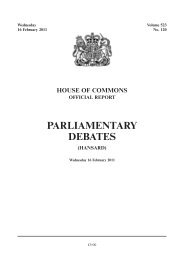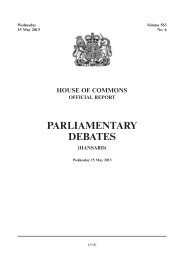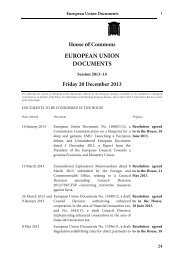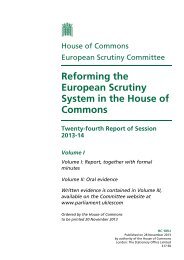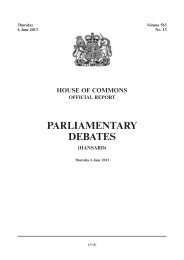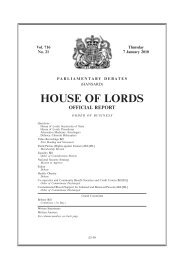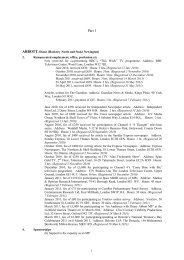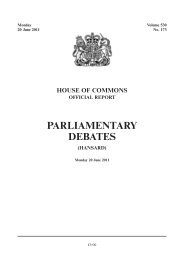Ticketing and Concessionary Travel on Public Transport - United ...
Ticketing and Concessionary Travel on Public Transport - United ...
Ticketing and Concessionary Travel on Public Transport - United ...
You also want an ePaper? Increase the reach of your titles
YUMPU automatically turns print PDFs into web optimized ePapers that Google loves.
Executive Summary<br />
Memor<str<strong>on</strong>g>and</str<strong>on</strong>g>um from Transacti<strong>on</strong> Systems Ltd, (TranSys) (TPT 19)<br />
<strong>Transport</strong> Committee: Evidence Ev 123<br />
— Transacti<strong>on</strong> Systems Limited, (TranSys) is the c<strong>on</strong>sortium that designed, developed, maintains<br />
<str<strong>on</strong>g>and</str<strong>on</strong>g> operates the Oyster smartcard transport ticketing system in L<strong>on</strong>d<strong>on</strong> under the terms of the 17<br />
year PFI PRESTIGE services c<strong>on</strong>tract that was signed in 1998.<br />
— PRESTIGE has been an undisputed success. 7.6 milli<strong>on</strong> journeys every working day are made<br />
using Oyster.<br />
— From the passenger perspective, smartcards can deliver increased c<strong>on</strong>venience <str<strong>on</strong>g>and</str<strong>on</strong>g> flexibility.<br />
— For the operator, smartcards can reduce costs of ticket selling, improve security through reduced<br />
cash-h<str<strong>on</strong>g>and</str<strong>on</strong>g>ling <str<strong>on</strong>g>and</str<strong>on</strong>g> provide better usage informati<strong>on</strong>.<br />
— The experience of L<strong>on</strong>d<strong>on</strong> shows that smartcard technology works <str<strong>on</strong>g>and</str<strong>on</strong>g> can help to reduce<br />
passenger c<strong>on</strong>gesti<strong>on</strong> <str<strong>on</strong>g>and</str<strong>on</strong>g> fraud. Savings from reduced fraud are extremely diYcult to estimate<br />
accurately <str<strong>on</strong>g>and</str<strong>on</strong>g> depend up<strong>on</strong> the extent to which the operator wishes to operate a closed system.<br />
However, the experience with gating <strong>on</strong> L<strong>on</strong>d<strong>on</strong> Underground shows that revenue growth<br />
immediately following introducti<strong>on</strong> of the gates averaged about 10%.<br />
— With the right policy directi<strong>on</strong> from Government, TranSys believes an ec<strong>on</strong>omically-viable<br />
integrated smartcard ticketing system across <strong>Transport</strong> for L<strong>on</strong>d<strong>on</strong> (TfL), Nati<strong>on</strong>al Rail <str<strong>on</strong>g>and</str<strong>on</strong>g> other<br />
transport modes is achievable.<br />
— For the bulk of passenger mass transit journeys in the UK, a smartcard ticketing system is the best<br />
way forward for enabling operator integrati<strong>on</strong> <str<strong>on</strong>g>and</str<strong>on</strong>g> delivering benefits to the passenger.<br />
Introducti<strong>on</strong><br />
The TranSys c<strong>on</strong>sortium provides, maintains <str<strong>on</strong>g>and</str<strong>on</strong>g> operates the Oyster smartcard transport ticketing<br />
system in L<strong>on</strong>d<strong>on</strong> under the terms of the 17-year PFI PRESTIGE services c<strong>on</strong>tract that was signed in 1998.<br />
The principal partners of the TranSys c<strong>on</strong>sortium are Cubic <strong>Transport</strong>ati<strong>on</strong> Systems (CTS) <str<strong>on</strong>g>and</str<strong>on</strong>g> Electr<strong>on</strong>ic<br />
Data Systems (EDS) who are resp<strong>on</strong>sible, respectively, for asset provisi<strong>on</strong> <str<strong>on</strong>g>and</str<strong>on</strong>g> operati<strong>on</strong>al services. Fujitsu<br />
<str<strong>on</strong>g>and</str<strong>on</strong>g> WS Atkins are also minor shareholders in the c<strong>on</strong>sortium.<br />
The PRESTIGE-Oyster system is designed to be multi-modal <str<strong>on</strong>g>and</str<strong>on</strong>g> smartcards work across L<strong>on</strong>d<strong>on</strong>’s<br />
Tube, Dockl<str<strong>on</strong>g>and</str<strong>on</strong>g>s Light Railway (DLR), tram, <str<strong>on</strong>g>and</str<strong>on</strong>g> bus network, as well as <strong>on</strong> specified nati<strong>on</strong>al rail services.<br />
Users with travelcards (daily, weekly or m<strong>on</strong>thly) can also travel <strong>on</strong> rail services within the Greater L<strong>on</strong>d<strong>on</strong><br />
area in all the z<strong>on</strong>es for which they have validity <strong>on</strong> their card.<br />
The Nati<strong>on</strong>al Audit OYce report <strong>on</strong> Achieving Innovati<strong>on</strong> in Central Government Organisati<strong>on</strong>s published<br />
in July 2006 stated “The project was developed to time <str<strong>on</strong>g>and</str<strong>on</strong>g> to budget <str<strong>on</strong>g>and</str<strong>on</strong>g> has w<strong>on</strong> several awards, such as<br />
the New Statesman “Modernising Government” award (2004), the MCA award for technology innovati<strong>on</strong><br />
<str<strong>on</strong>g>and</str<strong>on</strong>g> the PFI best <strong>Transport</strong> Award”.<br />
The Oyster smartcard has been an unqualified success since its launch in 2002, <str<strong>on</strong>g>and</str<strong>on</strong>g> the Oyster card is used<br />
by more passengers each day than any other smartcard system in Europe.<br />
TranSys will be working closely with TfL over the coming m<strong>on</strong>ths <str<strong>on</strong>g>and</str<strong>on</strong>g> years to achieve the shared visi<strong>on</strong><br />
of integrated smartcard-based ticketing within the Greater L<strong>on</strong>d<strong>on</strong> Authority (GLA) area.<br />
TranSys’ resp<strong>on</strong>ses to the <strong>Transport</strong> Select Committee’s questi<strong>on</strong>s are set out below, following the same<br />
numbering as set out in the Committee’s terms of reference.<br />
Integrated <str<strong>on</strong>g>Ticketing</str<strong>on</strong>g><br />
1. Is ticketing suYciently integrated across diVerent modes of transport <str<strong>on</strong>g>and</str<strong>on</strong>g> between diVerent geographical<br />
areas?<br />
1.1 No. However, the arrangements in L<strong>on</strong>d<strong>on</strong> show that integrati<strong>on</strong> is possible across modes<br />
(Underground, tram, buses, light rail, <str<strong>on</strong>g>and</str<strong>on</strong>g> specified nati<strong>on</strong>al rail services) when there is a will to achieve it.<br />
1.2 At present, the extent of ticketing integrati<strong>on</strong> varies within diVerent geographical areas, between<br />
diVerent geographical areas, <str<strong>on</strong>g>and</str<strong>on</strong>g> across diVerent modes of transport. Nati<strong>on</strong>al rail tickets are integrated<br />
between overground/mainline stati<strong>on</strong>s <str<strong>on</strong>g>and</str<strong>on</strong>g> through magnetic stripe tickets with L<strong>on</strong>d<strong>on</strong> Underground.<br />
1.3 However, outside of the L<strong>on</strong>d<strong>on</strong> Oysterised area there is little integrati<strong>on</strong> with local bus services in<br />
diVerent geographical areas, or with other forms of transport (light rail, metro). Customers are baZed <str<strong>on</strong>g>and</str<strong>on</strong>g><br />
irritated at the disjointedness of ticketing policy <str<strong>on</strong>g>and</str<strong>on</strong>g> possibly discouraged from using public transport by<br />
the need to queue <str<strong>on</strong>g>and</str<strong>on</strong>g> purchase more than <strong>on</strong>e ticket <strong>on</strong> multi modal journeys. If the government wishes to<br />
encourage the use of public transport, whether it be bus or rail, to reduce car usage <str<strong>on</strong>g>and</str<strong>on</strong>g> meet energy <str<strong>on</strong>g>and</str<strong>on</strong>g><br />
emissi<strong>on</strong>s targets it needs to enable public transport with “a c<strong>on</strong>venience factor”—get in <str<strong>on</strong>g>and</str<strong>on</strong>g> go—<str<strong>on</strong>g>and</str<strong>on</strong>g> then<br />
provide the service <str<strong>on</strong>g>and</str<strong>on</strong>g> capacity necessary.



